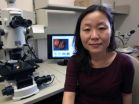(Press-News.org) Although scientists have known for centuries that many bacteria produce hydrogen sulfide (H2S) it was thought to be simply a toxic by-product of cellular activity. Now, researchers at NYU School of Medicine have discovered H2S in fact plays a major role in protecting bacteria from the effects of numerous different antibiotics.
In the study led by Evgeny Nudler, PhD, the Julie Wilson Anderson Professor of Biochemistry at NYU School of Medicine, researchers found evidence that H2S acts as a general defense mechanism against oxidative stress, the process through which many antibiotics kill bacteria. This information provides the basis for developing new techniques to suppress this universal bacterial defense mechanism and make bacteria more susceptible to antibiotics at lower doses. It also paves the way for reversing antibiotic resistance in human pathogens such as Staphylococcus, Pseudomonas, E. coli, and many others. The study's findings were published online on November 17 edition of Science.
"Surprisingly little has been known about H2S biochemistry and physiology in common bacteria" said Dr. Nudler. "We are excited about the potential impact this research may have on the growing problem of microbial resistance. These findings suggest a conceptually new approach, an adjuvant therapy that targets bacterial gas defenses and thus increases the efficacy of many clinically used antibiotics."
More specifically, the study showed that integrated mechanism of H2S-mediated protection against oxidative stress also protects against antibiotics. The research provides direct support for the emerging concept of the pro-oxidative action of many antibiotics. In addition, the study demonstrates that bacteria that generate both H2S and nitric oxide (NO) simultaneously, such as B. anthracis (a causative of anthrax), cannot survive without both gases, even under normal growth conditions. One gas makes up for the lack of the other and at least one of them is essential.
In a previous study Dr. Nudler and his colleagues demonstrated that NO plays a similar role in protecting bacteria from antibiotics (Science September 9, 2009). However, because NO is present in only a limited number of bacteria while hydrogen sulfide synthesis occurs in essentially all bacteria, the practical implications of this new finding is extremely wide-ranging.
###
About NYU School of Medicine
NYU School of Medicine, the medical school of NYU Medical is one of the nation's preeminent academic institutions dedicated to achieving world class medical educational excellence. For 170 years, NYU School of Medicine has trained thousands of physicians and scientists who have helped to shape the course of medical history and enrich the lives of countless people. An integral part of NYU Langone Medical Center, the School of Medicine at its core is committed to improving the human condition through medical education, scientific research and direct patient care. The School also maintains academic affiliations with area hospitals, including Bellevue Hospital, one of the nation's finest municipal hospitals where its students, residents and faculty provide the clinical and emergency care to New York City's diverse population, which enhances the scope and quality of their medical education and training. Additional information about the NYU School of Medicine is available at http://school.med.nyu.edu/.
Targeting bacterial gas defenses allow for increased efficacy of numerous antibiotics
Researchers discover role of H2S as defense mechanism against oxidative stress and antibiotics
2011-11-21
ELSE PRESS RELEASES FROM THIS DATE:
NASA's Chandra adds to black hole birth announcement
2011-11-21
New details about the birth of a famous black hole that took place millions of years ago have been uncovered, thanks to a team of scientists who used data from NASA's Chandra X-ray Observatory as well as from radio, optical and other X-ray telescopes.
Over three decades ago, Stephen Hawking placed -- and eventually lost – a bet against the existence of a black hole in Cygnus X-1. Today, astronomers are confident the Cygnus X-1 system contains a black hole, and with these latest studies they have remarkably precise values of its mass, spin, and distance from Earth. With ...
VLBA observations key to 'complete description' of black hole
2011-11-21
For the first time, astronomers have produced a complete description of a black hole, a concentration of mass so dense that not even light can escape its powerful gravitational pull. Their precise measurements have allowed them to reconstruct the history of the object from its birth some six million years ago.
Using several telescopes, both ground-based and in orbit, the scientists unravelled longstanding mysteries about the object called Cygnus X-1, a famous binary-star system discovered to be strongly emitting X-rays nearly a half-century ago. The system consists of ...
Study of flower petals shows evolution at the cellular level
2011-11-21
A new study of flower petals shows evolution in action, and contradicts more that 60 years of scientific thought.
The findings are reported by a scientist from UC Santa Barbara and a research team from Harvard University in the Proceedings of the Royal Society B this week.
Columbine flowers, known as Aquilegia, evolved several lengths of petal spurs that match the tongue lengths of their pollinators, including bees, hummingbirds, and hawkmoths. The petal spurs are shaped like a tubular pocket and contain nectar at the tip. The spurs grow from 1 to 16 centimeters in ...
Molecules on branched-polymer surfaces can capture rare tumor cells in blood
2011-11-21
The removal of rare tumor cells circulating in the blood might be possible with the use of biomolecules bound to dendrimers, highly branched synthetic polymers, which could efficiently sift and capture the diseased cells, according to new research at the University of Illinois at Chicago.
Dendrimers have been used to encapsulate drug molecules and serve as a delivery vehicle, but in the new study they were employed to capture circulating tumor cells by biomimicry -- using nanotechnology to create artificial surfaces much like those in real cells.
"We want to take advantage ...
US preterm birth rate under 12 percent, the lowest level in nearly a decade
2011-11-21
WHITE PLAINS, N.Y., Nov. 17, 2011 – The nation's preterm birth rate slipped under 12 percent for the first time in nearly a decade, the fourth consecutive year it declined, potentially sparing tens of thousands of babies the serious health consequences of an early birth.
The national preterm birth rate declined to 11.99 percent last year, according to the National Center for Health Statistics, which released its report "Births: Preliminary Data for 2010," today, the first-ever World Prematurity Day. Despite the improvement, still too many babies, one out of every eight, ...
Study: Ozone from rock fracture could serve as earthquake early warning
2011-11-21
Researchers the world over are seeking reliable ways to predict earthquakes, focusing on identifying seismic precursors that, if detected early enough, could serve as early warnings.
New research, published this week in the journal Applied Physics Letters, suggests that ozone gas emitted from fracturing rocks could serve as an indicator of impending earthquakes. Ozone is a natural gas, a byproduct of electrical discharges into the air from several sources, such as from lightning, or, according to the new research, from rocks breaking under pressure.
Scientists in the ...
Study explains how heart attack can lead to heart rupture
2011-11-21
For people who initially survive a heart attack, a significant cause of death in the next few days is cardiac rupture -- literally, bursting of the heart wall.
A new study by University of Iowa researchers pinpoints a single protein as the key player in the biochemical cascade that leads to cardiac rupture. The findings, published Nov. 13 as an Advance Online Publication (AOP) of the journal Nature Medicine, suggest that blocking the action of this protein, known as CaM kinase, may help prevent cardiac rupture and reduce the risk of death.
After a heart attack, the ...
Multidisciplinary team of researchers develop world’s lightest material
2011-11-21
Irvine, Calif., Nov. 17, 2011 – A team of researchers from UC Irvine, HRL Laboratories and the California Institute of Technology have developed the world's lightest material – with a density of 0.9 mg/cc – about 100 times lighter than Styrofoam. Their findings appear in the Nov. 18 issue of Science.
The new material redefines the limits of lightweight materials because of its unique "micro-lattice" cellular architecture. The researchers were able to make a material that consists of 99.99 percent air by designing the 0.01 percent solid at the nanometer, micron and millimeter ...
NIH-funded scientists identify potential malaria drug candidates
2011-11-21
Caused by four related parasites in the genus Plasmodium, malaria is transmitted to humans via the bite of an infected mosquito. Once the bite occurs, the parasites travel to the liver, where they usually multiply rapidly for about a week without causing symptoms. Symptoms begin when the parasites spread from the liver to the rest of the body through the bloodstream. However, the parasites can lay dormant in the liver for periods ranging from several months to years before an infected person demonstrates symptoms.
Most of the malaria drugs currently in development target ...
Soybean adoption came early by many cultures, archaeologists say
2011-11-21
EUGENE, Ore. -- Human domestication of soybeans is thought to have first occurred in central China some 3,000 years ago, but archaeologists now suggest that cultures in even earlier times and in other locations adopted the legume (Glycine max).
Comparisons of 949 charred soybean samples from 22 sites in northern China, Japan and South Korea -- found in ancient households including hearths, flooring and dumping pits -- with 180 modern charred and unburned samples were detailed in the Nov. 4 edition of the online journal PLoS ONE, a publication of the Public Library ...
LAST 30 PRESS RELEASES:
Decoupling the HOR enhancement on PtRu: Dynamically matching interfacial water to reaction coordinates
Sulfur isn’t poisonous when it synergistically acts with phosphine in olefins hydroformylation
URI researchers uncover molecular mechanisms behind speciation in corals
Chitin based carbon aerogel offers a cleaner way to store thermal energy
Tracing hidden sources of nitrate pollution in rapidly changing rural urban landscapes
Viruses on plastic pollution may quietly accelerate the spread of antibiotic resistance
Three UH Rainbow Babies & Children’s faculty elected to prestigious American Pediatric Society
Tunnel resilience models unveiled to aid post-earthquake recovery
Satellite communication systems: the future of 5G/6G connectivity
Space computing power networks: a new frontier for satellite technologies
Experiments advance potential of protein that makes hydrogen sulfide as a therapeutic target for Alzheimer’s disease
Examining private equity’s role in fertility care
Current Molecular Pharmacology achieves a landmark: real-time CiteScore advances to 7.2
Skeletal muscle epigenetic clocks developed using postmortem tissue from an Asian population
Estimating unemployment rates with social media data
Climate policies can backfire by eroding “green” values, study finds
Too much screen time too soon? A*STAR study links infant screen exposure to brain changes and teen anxiety
Global psychiatry mourns Professor Dan Stein, visionary who transformed mental health science across Africa and beyond
KIST develops eco-friendly palladium recovery technology to safeguard resource security
Statins significantly reduce mortality risk for adults with diabetes, regardless of cardiovascular risk
Brain immune cells may drive more damage in females than males with Alzheimer’s
Evidence-based recommendations empower clinicians to manage epilepsy in pregnancy
Fungus turns bark beetles’ defenses against them
There are new antivirals being tested for herpesviruses. Scientists now know how they work
CDI scientist, colleagues author review of global burden of fungus Candida auris
How does stroke influence speech comprehension?
B cells transiently unlock their plasticity, risking lymphoma development
Advanced AI dodel predicts spoken language outcomes in deaf children after cochlear implants
Multimodal imaging-based cerebral blood flow prediction model development in simulated microgravity
Accelerated streaming subgraph matching framework is faster, more robust, and scalable
[Press-News.org] Targeting bacterial gas defenses allow for increased efficacy of numerous antibioticsResearchers discover role of H2S as defense mechanism against oxidative stress and antibiotics


